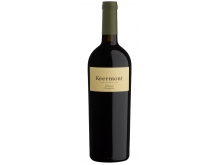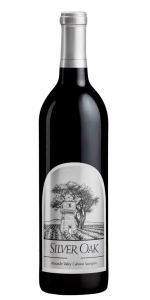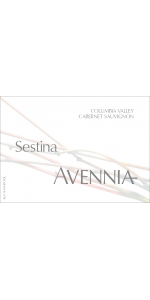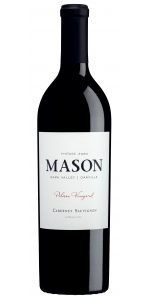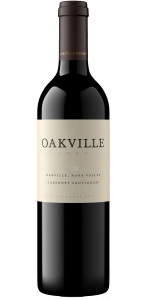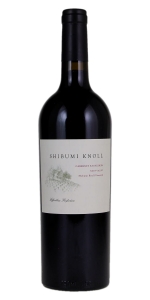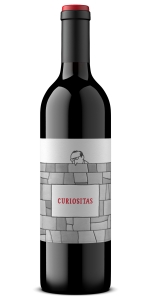Keermont Cabernet Sauvignon 2020
| Country: | South Africa |
| Region: | Western Cape |
| Winery: | Keermont Vineyards |
| Grape Type: | Cabernet Sauvignon |
| Organic: | Yes |
| Vintage: | 2020 |
| Bottle Size: | 750 ml |
Silver Oak Alexander Valley Cabernet Sauvignon is made from 95.2% Cabernet Sauvignon, 2.5% Cabernet Franc, 1.9% Merlot, 0.4% Petit Verdot
The Silver Oak Alexander Valley Cabernet Sauvignon 2019 has notes of red cherry, raspberry, blackberry, iris, vanilla and clove. Ruby in color, this elegant wine has great acidity and lift on the mid-palate. Black currant and warm baking spices linger with a deep and fruity finish. It will provide drinking pleasure through 2047 given proper cellaring.
Review:
Silver Oak's 2020 releases of Napa and Alexander Valley Cabernets are downright impressive. Tasted four years after the fires, in September of 2024 at the Alexander Valley winery, neither wine showed any sign of the hardened tannic structure or overwrought fruit often associated with the vintage. Instead, these wines remain true to Silver Oak’s signature style, with blackcurrant, fig, and plum fruits layered with white pepper, sweet cedar, and coriander spice. Medium-bodied, with sculpted tannins that persist through the lengthy finish, the Alexander Valley Cabernet in particular retains all the hallmarks of a balanced, inviting, and vibrant Silver Oak red.
-Decanter 94 Points
Truly gorgeous, fruity, velvety and enjoyable for a full-bodied cabernet. It is rich in blueberries, cherry cream, black cherries and raspberries on the palate, with very smooth, layered tannins and a soothing mouthfeel. So easy to drink now, but it will age well, too.
-James Suckling 94 Points
Avennia Sestina Red Blend is made from 77% Cabernet Sauvignon, 17% Merlot, 6% Cabernet Franc.
The Sestina is a poetic form from Medieval France. Just as a contemporary poet can use an old form like the Sestina to express modern ideas, we use the traditional Bordeaux blend to make modern wines that express Washington fruit. Sestina is our vision for an old vine blend where the focus is on structure, balance, and complexity. This wine is designed for the cellar, but is enjoyable now.
Sestina: This wine is a blockbuster, with black currant, black raspberry, saddle leather, freshly tilled earth, vanilla, and violet on the nose. Exceedingly rich and balanced on the palate, with great poise and structure for long aging. The finish echoes with fresh black fruits, minerally touches, and floral notes.
Review:
The 2020 Sestina showed beautifully, with lots of ripe black fruits, tobacco, and spring flower notes in a medium to full-bodied, fresh, focused, elegant style. It has fine tannins and a great finish and should drink nicely right out of the gate. The tannins here are terrific.
Jeb Dunnuck 94-96 Points
Mason Cellars Pelissa Vineyard Cabernet Sauvignon is made from 100 percent Cabernet Sauvignon.
The 2020 Mason Oakville Cabernet Sauvignon is quintessentially Oakville from nose to finish. Attractive fresh blackberry, red current and chocolate with a hint of sweet oak boast out of the glass. This wine showcases graphite, velvety tannins and concentrated, beautifully balanced flavors with a bit of spice and white pepper. These bold flavors typical of Oakville Cabernet are rounded out with velvety tannins, a weighty mid-palate and a long, juicy finish.
Production Notes:
The fruit was delicately hand-picked in the early morning hours and brought into the winery for processing. The grapes were crushed, about 60% whole berry, and cold soaked for three days before being inoculated for primary and malo-lactic fermentation. Once dry, the wine was put down to barrel for 20 months in medium toast French oak, 25% of which was new.
Vineyard Notes:
Grapes for our 2020 Mason Cabernet Sauvignon are sourced exclusively from the Pelissa Vineyard in Oakville. This vineyard spans 60 acres and is planted to Old BV Clone 7 Cabernet Sauvignon as well as Zinfandel. This vineyard is named for Andrew and Babe Pelissa, who after their marriage on August 30, 1930, made their home at the site of this vineyard which, at the time, was a dairy. Oakville is the core of Napa Valley’s famed Cabernet Sauvignon production, and this site is no exception with the flawless blending of climate and soil to create a remarkable wine.
Review:
“This firmly structured, well-balanced wine has the feel of a classic Bordeaux blend. Just-ripe red and black fruits blend with subtle toast, cedar and mint on a moderately tannic, slightly tangy texture. The wine is tasty enough to decant and drink soon with grilled lamb chops or roast chicken. Best from 2026–2036.” – Jim Gordon
-Wine Enthusiast 94 Points
The 2020 Oakville Winery Cabernet Sauvignon exhibits aromas of cherry and raspberry with notes of fresh roses, vanilla, dust, and pencil shaving. The rhythmic structure between the granular tannings and the vibrant acidity allows the sensation of a long, refreshing finish. This Cabernet Sauvignon can be aged for a decade bringing all the earthy components of a classic Napa Cab.
A New York strip steak with butter, mushrooms, and herbs will melt when you pair it with this wine.
The 2020 Cabernet is a shining example of how delicious, elegant and beautiful our Cabernet can be. The aromas of ripe plum, black cherry and stone fruits entice the nose. The wine is beautifully structured with a soft, velvety feel on the palate. The soft, subtle tannins make it seem that you are drinking a more mature wine. The hint of spice integrated with dark stone fruits segue into a long, lingering and enticing mouthfeel. This vintage is not one to miss, it’s approachable now and destined to be off the charts in years to come
Review:
Lastly, the 2020 Cabernet Sauvignon Shibumi Knoll Vineyard is all varietal and spent 22 months in 75% new barrels. It's another beautifully balanced and impeccably made wine from this team that has tons to love, and in this case, it certainly represents a relative value as well. Cassis, darker chocolate, scorched earth, and graphite are just some of its aromatics, and it's concentrated and has full-bodied richness, fine tannins, and the pure, layered, impressive style of the vintage front and center.
-Jeb Dunnuck 94 Points
The Walls Curiositas Cabernet Sauvignon is made from 100% Cabernet Sauvignon.
The Walls Cabernet Sauvignon comes from a variety of vineyards in the Red Mountain AVA providing structure and power on the nose and palate. Extremely aromatic and super silky tannins – loads of freshness, energy, full spectrum and super complex, with that great combination of weightlessness but great texture and length.
Review:
Coming from Red Mountain and 83% Cabernet Sauvignon and 17% Cabernet Franc brought up in 80% new French oak, the 2020 Cabernet Sauvignon Curiositas offers more red and black fruits to go with classic Red Mountain minerality, notes of graphite and tobacco, full-bodied richness, and building, firm, yet ripe tannins. It's going to need 3-5 years of bottle age, but it’s a classic expression of this terroir.
- Jeb Dunnuck 94-96 Points
Keermont Cabernet Sauvignon grows in Keermont's Cottage Lane Vineyard on the mid-slopes of the Helderberg. This vineyard is situated on the crest of a ridge (320m above sea level) so has aspects ranging from East through North to West. It is very exposed resulting in small vines with low yields. This has allowed to make a relatively fine grained Cabernet, but the clay soils translate to a wine with power, tension and fresh acidity. They blend in a couple of barrels of other varieties to add to the complexity of flavor and tannin structure.
All grapes used in producing the wines are grown on Keermont Vineyards. Most of the vineyard parcels grow on deep red clay rich soil derived from sandstone and granite and are surrounded by indigenous ‘fynbos’ vegetation. The vineyards are planted on steep mid-slopes high up in the valley between the Stellenbosch and Helderberg mountain ranges. Aspects vary from North East through North to West facing between 250 and 400 meters above sea level.
Dark ruby red in color, this is quite a serious vintage with a complex bouquet of ripe red berry fruit, cedarwood, and typical ‘fynbos’ flowers. The palate is full bodied, but gentle. Tannin structure is full and dense and coats the palate while the natural acidity keeps the ripe fruit in check. Savory notes of tomato paste and cloves add character to the bright red strawberry and cassis flavors which linger into a long, tight finish. Drink 2020 – 2035.
Review:
"Something of a crowd pleaser from Alex Starey, this is a comparatively forward cuvée of Cabernet Sauvignon and 10% Cabernet Franc. Supple, ripe and perfumed, it combines fynbos and dried herb aromas, fig and mulberry flavours, supple tannins and plenty of body and alcohol. 2023-29"
- Tim Atkin (South Africa 2023 Report), 91 pts
The Keermont Estate and Vineyards
Located just beyond Stellenbosch, Keermont Vineyards is nestled in farm land in the beautiful valleys of South Africa. Keermont uses their name to honor the former farm, Keerweder, that once occupied their land. The word “keerweder” means a dead end in a valley. The literal translation is “blocked again”, which is in reference to the early settlers being blocked by the terrain when trying to pass through the valley.
The Keermont winery building and vineyards actually lie in the shadow of Guardian Peak, or “Suurberg”. This location is ideal for Keermont, as the fruit on this mountain is often compared to the grapes of Napa Valley’s famous Howell Mountain AVA.
In 1694, Jan Jac Van Dyk founded the land in the Blaawklippen Valley that is the location of present day Keermont. Other wineries such as Waterford, Dornier, and Stellenzicht are also on the land once owned by Van Dyk. The earliest account of a European landowner utilizing the area for agricultural use are Van Dyk’s records. Afterwards, the potential and beauty of the Blaawklippen Valley attracted many other landowners to the area and the land was divided into individual farms.
Mark and Monica Wraith bought into this land by purchasing the Fleurfontein and Keerweder III farms in 2003. They combined the two farms into the Keermont Vineyards Estate. The couple still live on the Keermont land with their family. Alex Starey is the Keermont winemaker. In 2005, Keermont began a major vineyard planting program and it now holds 27 ha under vine. In 2007, Keermont releases its first vintage, from a crop of only 5 barrels or 108 cases. In 2010, the physical Keermont winery building, complete with offices, processing facilities, barrel rooms, and a tasting room, was converted from the former spring water bottling plant that had once resided on the Fleurfontein farm. The total farm acreage for Keermont Vineyards is 157 hectares or 388 acres, with 27 hectares under vine. 18 hectares produce red varietals such as Cabernet Savignon, Merlot, and Syrah. 9 hectares hold the white varietals like Chenin Blanc, Chardonnay, and Viognier. Keermont also boasts Chenin Blanc vines that are over forty years old and used by De Trafford winery. Keermont aims to create wines that reflect their beautiful land and the particular year’s vintage condition. Keermont focuses on using minimal chemical fertilizers, few pesticides, and irrigate as little as possible. No fining or filtration is practiced on the Keermont Estate. Keermont desires a natural, harmonious vineyard that will in the long run produce better quality wines.
The goal of this estate is to make superior blends. The wines to be produced, but not written in stone, are:
Keermont Red – 40 % Cabernet Sauvignon, 40% Merlot, 20% Syrah.
Keermont White – 70% Chenin Blanc, 30% Viognier and Chardonnay
Dessert wine in exceptional vintages
Keermont Syrah – Syrah, Mourvedre, Viognier
Some wines from Keermont Winery:
- Keermont Red Blend
- Keermont Syrah
- Keermont White Blend Terrasse
Any Keermont wines we have in stock are listed below, if you don’t see the wine you are looking for please don’t hesitate to ask for it.
- back
All older vintage wines have been purchased from a single collectors cellar. Pictures can be requested before shipment.
Dominique Piron Morgon Cote du Py is made from 100 percent Gamay.
The Morgon Cru is based in the heart of Northern Beaujolais. Côte du Py is the heart of Morgon, a little hill of very old blue stone rocks - the oldest soils of Beaujolais (around 430 millions years old), with a typical blue color.
Côte du Py has been known for centuries for being the best terroir of the village, producing long lived wines with strong structure and flavors.
Wines of the Côte du Py are very dark, profound and dense. Classic aromas of red berries, cherry, kirsh. Fruity, structured and mineral in the mouth with graphite flavors and spicy notes of black and white pepper. Wine can age up to 10 years.
Hand picked grapes are sorted manually and destemmed for 50 to 70%. Fermentation starts in concrete tanks and lasts for 18-25 days with remontages and pigeages. Then after pressurage starts the aging, for 2/3 in concrete tanks, and 1/3 in recent French oak barrels with batonages on fine lies only. After 10 month we do the blending, keeping only the best cuvees and best barrels, and do the bottling.
Pairs well with red meat like beef, duck and game (Hare, Dear, Wild Pork,…), cheses.

